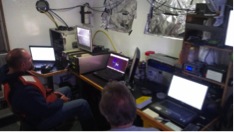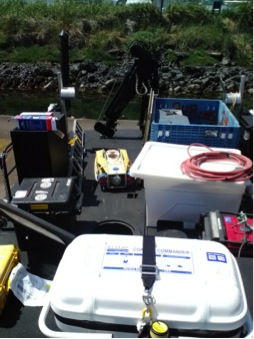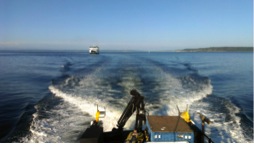Tidal Generation and Managing Currents for Underwater Operations
Whether the final product is oil, gas or electricity, sometimes pipelines or cables need to span areas that are not easily conducive to underwater inspection and maintenance operations. These products are extremely important to daily life, and because of this, industry leading companies are constantly improving the equipment and methods necessary to both place these assets and to keep them in good operating condition even in the most challenging areas. Operating around swift ocean currents at depth is one of the tougher challenges presented by the location of many offshore pipelines and cables.
 Operations Control Setup
Operations Control Setup
Recently, Hibbard Inshore was contracted to address the seabed assessment, site selection, and cable route survey needs for a tidal generation station in the United States which will consist of two turbines. For each project of this nature, the team assesses each unique survey location for its particular challenges in order to select the optimal vessel, remotely operated vehicle (ROV) and survey equipment spread to fit the project’s needs. The Hibbard Inshore team along with its partners has worked together for years to develop appropriate methods and equipment to address a wide variety of marine construction and inspection applications. This project was no different. The unique challenge here was that while the particular area was not very deep by ocean standards, the tidal currents in the survey area were extremely brisk. The currents had a negative effect on two earlier attempts by others to collect the necessary survey data in the proposed work area. After looking at the situation, the team decided on using a Sub-Atlantic Navajo ROV in a live-boat configuration. This meant that the ROV was run without a tether management system (TMS). The ROV system was coupled with the appropriate navigation and tracking systems for geo-referencing of the data allowing successful completion of the surveys.
 Navajo ROV and Support Equipment Loading on to Small Work Vessel
Navajo ROV and Support Equipment Loading on to Small Work Vessel
The ROV has a very high thrust to size ratio, and the live-boat configuration reduced the available cross-sectional area of the equipment allowing it to fight the current more efficiently. Further advantages of this method included the use of a small crew and small vessel. The live-boat configuration reduced the overall size and weight of the required equipment allowing the team to also reduce the size of the crew needed to operate the vessel, survey system and ROV. Additionally, the vessel did not require a mooring system or a dynamic positioning system to maintain the position of the ROV allowing for the use of a smaller (45’) vessel. Productivity was maximized because time was not required to place and move anchors across the survey area, and the ROV could be deployed very quickly to take maximum advantage of the lower current periods afforded by the change in tides. Finally, the smaller system and vessel are easy to mobilize and reduce overall associated logistical costs to the customer.
 Navajo ROV on Tail of Vessel while Underway
Navajo ROV on Tail of Vessel while Underway
The survey area consisted of three separate passes of the proposed cable lay area of approximately two kilometers per pass along with a survey of the proposed area for the installation of the units which was approximately 100 meters by 150 meters where grid lines were run on ten meter centers. The nominal site depth was approximately 60 meters, and the Hibbard Inshore team was able to complete the full survey scope in three operations days making the project a success despite the difficult currents.

